Nearing the end of summer we can always find some neat-looking critters somewhere on the vegetation that surrounds us. Many times the bugs and insects are making a meal out of a carefully planted and nursed garden flower or plant. Sometimes we see cool-looking insects perched on the house or vehicles. If they’re different than ones we normally see, somebody runs to get the camera.
Today, looking out in the back yard I noticed from a distance that my small White Flowering Dogwood trees, Cornus florida, were really taking a beating. The leaves were obviously being eaten as the little trees looked almost stripped bare from where I stood on the porch. But what or who was eating the leaves?
Closer inspection revealed two small visitors to the dogwood trees and they were still munching away as I snapped these pics.

This brown caterpillar with four white head spots — dashes really — seemed very busy munching on a dogwood leaf.
I didn’t touch it with my bare hands because I saw long hairs, or setae, projecting from its body. Some of the caterpillars have what are called urticating spines which can really pack a wallop and sting ya’ good! I wasn’t taking any chances with getting stung so I carefully removed this critter from the tree before it ate the last leaf.
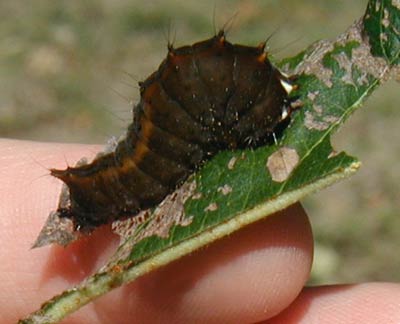
Brown caterpillar with white dashes on its head and a lighter brown streak down its back.
This little green fellow was on the underside of a dogwood leaf. Its back was rather dome-shaped and its belly did not have distinct feet or legs. The head end was definitely more rounded than the pointy tail end, but as it sat on the plant I couldn’t really see a head per se. As close as I can tell its the Yellow-shoulder Slug caterpillar, Lithacodes fasciola .
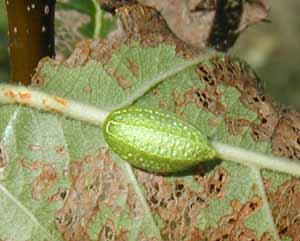
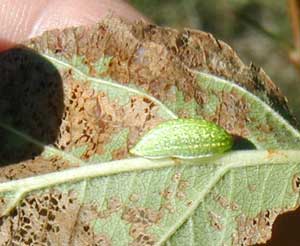
Undulating its “belly” allowed this little yellow-green fellow to move fairly quickly.
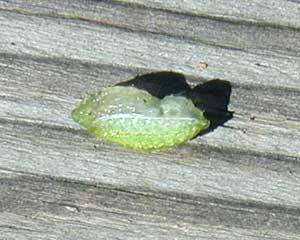
Lying on its side — notice the shadow of a wave of motion that traveled down the length of its body as the slug caterpillar tried to upright itself.
This is the time of year that the asters and goldenrods are blooming profusely in open, fallow fields. At the edge of our woods, where the tree line meets what we call a backyard, a small group of White Wood Asters, Aster divaricatus, blooms every year.
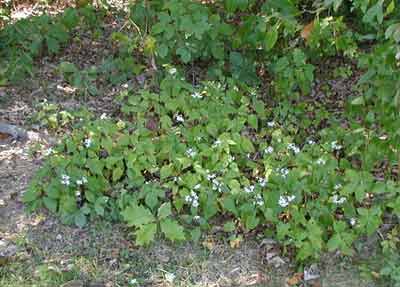
A small patch of low-growing White Wood Asters lies in the shade except for some filtered sunlight that reaches them in the early part of the day.
The white flower heads lose their short petals easily, so these flowers are not for picking. We just appreciate them being there.
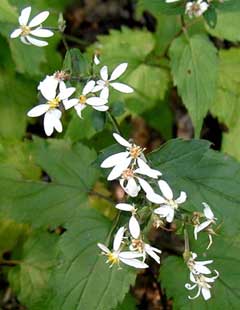
The False Solomon Seal berries are now crimson red with white speckles. Their collective weight draws the tall stems almost down to the ground. Eventually, the berries will either be eaten or lay upon the ground to start the growing cycle all over again.
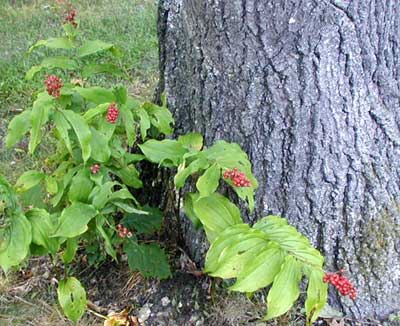
Underneath the shade of a White Oak several native False Solomon Seal plants lend color to the area with their bright red berries that appear every autumn.

False Solomon Seal berries form at the terminal ends of the two to three feet tall plants and mature to a bright red color with speckles of white.
the brown caterpillar looks to be the Clear Dagger Moth, Acronicta clarescens. See Wagner page 337
Hi Jane and John,
Thanks for the identification! Seems like that’s another field guide I should add to my collection.
Stop by again!
Jane and John- you are awesome! (and you too wilde)
I found the brown caterpillar on my pear and couldn’t find him in Wagner’s guide until J&J gave the page #. (The caterpillar on my tree was a light orange brown with almost a touch of green, but everything else about him was the same.) You were on the first page of the google image search for “caterpillar identification brown”. Thank you for the lovely picture and the ID!
Seems like the more you look the more you see out there. We’re finding out that caterpillars are quite variable – and they’re always hungry!
Thanks for stopping by, Becca!
i have these brown pinecone looking cocoons on my evergreen bush with brown caterpillers coming out the tops to eat the tree? what are they? i’ve never seen anything like it?
please help,
Hi there, Creeped Out!
The brown cocoons are probably evergreen bagworms. Check out the photo here: brown cocoons on pines.
You can pick them off to save the branches. If you’re grossed out, just wear a pair of gloves and drop the cocoons into a pail of water. Good luck!
I tend not to leave a great deal of responses, but i did a
few searching and wound up here Caterpillars Eat Dogwood Leaves While White Wood Asters and False Solomon
Seal Berries Brighten the Woods. And I do have a few
questions for you if it’s allright. Could it be simply me or does it seem like some of these comments appear as if they are left by brain dead folks? 😛 And, if you are posting on additional online social sites, I would like to follow anything new you have to post. Would you make a list of every one of all your public sites like your Facebook page, twitter feed, or linkedin profile?
Welcome Nancy, glad you found Wildeherb!
I was curious if you had specific problems with caterpillars where you are? We have seen a huge increase in their activity now that the trees are fully in leaf and growing. Just yesterday I saw a wasp consuming a green caterpillar that was unfortunate enough to be found by the wasp. That just shows it’s a good practice to let the wasps alone for they are performing a needed service.
Stay tuned tune to wildeherb for more!
Hi, it sounds like some comments in the post are negative towards caterpillars, but please don’t be. When is the last time you saw a butterfly? Remember years ago they were everywhere? Butterflies are caterpillars first. They need to eat to get there. Most caterpillars can only eat a specific food. For example Monarch’s can only eat milkweed. But the pesticides and herbicides we are spraying are wiping them out! Wiping out native plants and replacing them with exotic plants are a huge problem as well. We are on a rapid decline of monarchs, swallowtails, fritillary’, painted lady, and so on. Please please please identify the caterpillar before destroying it. The grizzled skipper is so endangered I’m not sure we’ll ever see another in some of our life times! They can only eat wild strawberries and one other plant to get from caterpillar to butterfly. Wild violets people are at war with. Are the ONLY plant a fritillary butterfly caterpillar can eat. When we destroy it. We destroy the butterfly. Years ago when I was younger I was at war as well, but one morning it occurred to me that I was wrong. I’m fighting a war against a natural cycle. So I decided to learn all I could to support the natural cycle. I plant all I can fit butterfly larvae. Violets, milkweed, hollyhock, parsley, dill, etc. I also plant a bunch of extra black eyed Susan and cone flowers for the rabbits. As well as a 10 ft. Diameter part of my yard for the rabbits, chipmunks, cocoons, and bees. A huge butterfly/bee garden for pollen. I keep my yard very pretty and groomed, but I do it all while contributing as much as I can to wildlife. I get to enjoy the bunnies, all kinds of amazing birds, butterflies and different sorts of bees. We all live in peace and harmony. No fighting with rabbits or pollinators. It’s amazing and serene to watch all the wildlife interact with me sitting right by enjoying the beauty. I hope I helped some people see how nice it is and much easier to live on n harmony with the little critters and spend less time stressing out about sprays, traps and fences. Enjoy life and all the good we have in nature????????
Bravo, Maryann!
Thank you so much for your comments. I now know why we see a bunch of fritillary butterflies on purple cone flowers in the summertime. “Wild violets people are at war with. Are the ONLY plant a fritillary butterfly caterpillar can eat.” Did not know that, but I love seeing the wild violets in the yard so I let them be and even postpone mowing the lawn to let the small plants live out their lives as much as possible so we can enjoy the violets the next year. I have to admit I haven’t yet seen a fritillary caterpillar on a violet yet, but you can bet I’ll be looking!
By mowing around curious-looking plants and letting the ones I don’t know grow long enough to find out what they are, we’ve been treated to several new ones…yellow-flowering wild indigo and orange butterfly weed. Totally appreciate them and living in harmony with nature!